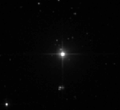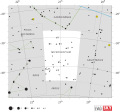AU Microscopii (AU Mic) is a young red dwarf star located 31.7 light-years (9.7 parsecs) away – about 8 times as far as the closest star after the Sun...
40 KB (3,392 words) - 11:18, 19 July 2024
Microscopium (redirect from Microscopii)
AU Microscopii and HD 205739—have been determined to have planets, while other star —the Sun-like star HD 202628— has a debris disk. AU Microscopii and...
26 KB (2,877 words) - 08:21, 17 August 2024
"A planet within the debris disk around the pre-main-sequence star AU Microscopii." Nature 582, no. 7813 (2020): 497-500. Günther, Maximilian N., Zhuchang...
28 KB (2,314 words) - 15:40, 6 September 2024
"A planet within the debris disk around the pre-main-sequence star AU Microscopii". Nature. 582 (7813): 497–500. arXiv:2006.13248. Bibcode:2020Natur.582...
139 KB (7,640 words) - 03:06, 12 August 2024
their brightness. This pair lies physically near the red dwarf star AU Microscopii, which may mean they form a wide triple star system. In 1926, Dutch-American...
14 KB (1,260 words) - 23:52, 26 July 2023
first optical images of debris disks surrounding the nearby red dwarf AU Microscopii and the bright star Fomalhaut. Kalas' Hubble Space Telescope image of...
9 KB (839 words) - 16:32, 3 August 2024
around Gliese 49 B M5V GJ 3988 32.30 ± 0.01 M5V has 1 known planet AU Microscopii 32.32 ± 0.33 Microscopium M1Ve 8.73 has 2-4 known planets HD 232979...
52 KB (2,086 words) - 16:17, 7 September 2024
System. Most known debris disks have radii of 10–100 astronomical units (AU); they resemble the Kuiper belt in the Solar System, although the Kuiper belt...
27 KB (2,357 words) - 19:16, 17 July 2024
or Flying Saucer Nebula). Other edge-on disks (e.g. Beta Pictoris or AU Microscopii) and face-on disks (e.g. IM Lupi or AB Aurigae) require a coronagraph...
29 KB (3,603 words) - 05:21, 30 August 2024
smaller than 100 Myrs. Other examples are K2-33b, V1298 Tauri b and AU Microscopii b. Of these systems DS Tuc is the brightest and it is a good target...
15 KB (1,417 words) - 21:26, 30 July 2024









